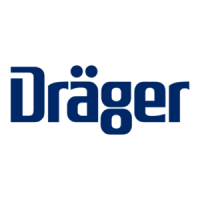Mounting | en
Instructions for use | Flame 1500 9
Further standards can be found in the EU DoC at the end of this document.
2.6 Explanation of type-identifying marking and
symbols
The flame detector is fitted with a label that shows the certification and
conditions within which it can operate.
The following label is an example only.
3 Mounting
3.1 Prerequisites for installation
When selecting a mounting position for the flame detector, observe the
following:
– Ensure that the flame detector has an unobstructed view of the areas to be
protected.
– Ensure that the mounting position is free from vibration or movement.
– Ensure that the mounting position has sufficient support for the flame
detector and allows for horizontal adjustment.
– Ensure that the flame detector is aimed downwards by at least 10° to 20°.
This will reduce the build-up of contaminants on the lens.
– Ensure that the flame detector is protected from sources of impact damage
and from being knocked out of alignment.
– Install the flame detector as far away as possible from local sources of
possible electrical interference, such as X-rays, RF (radio frequency)
interference or electrostatic discharge.
– Ensure that the area under observation has sufficient detector coverage for
all possible hazards (multiple detectors may be required) considering any
obstructions and congestion.
– Minimize the exposure of the enclosure front cover window to contaminants
such as oil, water (deluge water, rain, and sea spray), snow, and ice. Where
the flame detector is to be mounted at a low level, avoid contamination from
equipment situated above the mounting position.
– If dense smoke is expected to accumulate at the onset of the fire, the flame
detector should be mounted 1 - 2 m below the ceiling level where possible.
– Ensure there is maintenance access to the flame detector (e.g., direct,
ladder or scaffold access).
– Ensure that mounting supports are compatible with the flame detector
mounting brackets.
– Ensure that the flame detector does not have a direct or reflected view of
any sources of flame used during normal operations, such as flare stacks.
– Ensure that the flame detector is positioned so that it is not directly facing
hot surfaces.
All these issues are crucial to a successful installation. They should be
observed during the detailed design, construction, and commissioning phases
of the installation of a fire detection system.
3.2 Detector coverage
Software analysis of the actual detector field of view may be required to ensure
adequate coverage of the hazards. This analysis can also be used to optimize
the number of detectors and the loop configuration.
3.3 Power and cable requirements
The flame detector requires a supply voltage of 18 - 32 Vdc at the input
terminals.
Cable selection
The installation location and local regulations and standards determine the
cable specification.
Cable to be used for the installation must be selected with a temperature rating
of greater than 25 °C above the maximum ambient temperature.
50287
AMBIENT: -60 ºC +85ºC
FM21ATEX0012X
IECEx FMG 21.0009X
Maximum Voltage: 32VDC
Maximum Current: 700mA
TYPE 4X, IP66
Class I DIV 1 GROUPS B,C,D T4
Class I Zone 1 AEx db IIC T4 Gb
Ambient: -50ºC to +85ºC
II 2 G Ex db IIC T4 Gb
WARNING: DO NOT OPEN WHEN EXPLOSIVE ATMOSPHERE MAY BE PRESENT WARNING: REFER TO FLAME 1500 TECHNICAL MANUAL BEFORE INSTALLING OR MAINTAINING THIS UNIT
Class 1 High & Standard Sensitivity
Class 2 Low Sensitivity
2809-CPR-E0019
Angle of reception 90º
Do not repair flame paths contact manufacturer
Seal conduit within 18" of enclosure entrance
3260
EN54-10
Dräger Safety AG & Co.
KGaA
Revalstraße 1
23560 Lübeck, Germany
TYPE:
FLAME 1500
SERIAL No:
YEAR:
ENTRY:
Single
Dual
M25
M20
½"NPT
¾"NPT

